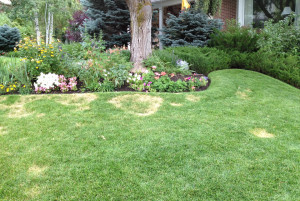Necrotic Ring Spot

Necrotic ring spots are caused by a fungus (ophiosphaerella korrae) that attacks the roots of grass. In Utah, the disease is particularly damaging to cool season grasses such as Kentucky bluegrass. Shaded areas of lawn are usually most vulnerable to this fungal disease; however, necrotic ring spots can occur in any area of lawn.
Signs and Symptoms:
Typically, scattered light green patches and “smoke rings” about 2″ to 6″ in diameter begin to appear. These patches enlarge and then rapidly fade to reddish-brown and, finally, become straw colored. Symptoms generally begin to develop as temperatures reach 85 degrees and become more evident during hot, dry periods. Usually, some healthy grass remains in the center giving a “frog eye” or “doughnut” shaped look. Extensive damage occurs as rings become numerous and overlap. They may increase in size and number for several years. This disease is particularly damaging to Kentucky bluegrass. Sunny or shaded areas of lawn are vulnerable. Rings in shady and damp areas are very difficult areas to control.
Green Pointe Practices for Control:
1. Three applications of Ring to Green, a pesticide free soil enhancement, are required to help control the disease. Preventive Spring Treatments are made 60-75 days apart beginning in mid May of the current growing season. Active treatments can start and be made anytime during the season. It is recommended that the entire lawn be treated with Ring to Green to provide uniform greening. Lawn areas spot treated with Ring to Green usually green up more than untreated areas. These treatments may not always control the disease, but we have found treatment frequently demonstrate positive results within 30 – 60 days. We will apply the treatments when the timing and conditions are optimum to maximize the best results possible. We have had good success with Ring to Green treatments as we are treating and enhancing the soil where the disease is and not just treating the symptoms that show up in the turf on surface. (See Picture above) We generally attain good disease control results; however, we do want you to be aware Necrotic Ring Spot disease is very difficult to control.
Cultural Practices for Control: (Things you can do)
1. Aerating your lawn each year (twice if possible) & hand aerating localized problem areas has proven to be a very helpful and important control factor, especially in conjunction with Ring to Green applications. Aeration helps improve water drainage, air flow and helps break down the thatch layer.
2. Practice proper watering. It is best to water in the affected areas between 6 p.m. and 12 a.m., so the grass blades will start to dry before daybreak. Avoid daytime and early evening watering as it tends to increase the activity of lawn disease. Maintain adequate soil moisture, however, do not over water. Too much water causes shallow roots & seems to increase the incidence of disease. Maintaining a regular fertilization schedule is imperative.
3. Maintain a mowing height of 2 ½” to 3” and remove no more than 1/3 of the leaf blade at a single mowing. This mowing height will encourage drought tolerance, root tillering, improved injury recovery, better turf color and a healthier lawn overall.
4. Overseed scarred areas with high quality seed from a reliable seed supplier. Select seed that is resistant to this and other diseases. Prior to seeding, vigorously rake scarred areas to assure that the new seed comes in contact with the soil. Be sure the seed is covered / incorporated into the soil. Keep new seedlings damp until the new lawn is established. If you chose to replace or fill in the damaged areas with sod, insure the sod you select was grown from a disease resistant blend of seeds.
The Green Pointe staff is always ready to assist you with your lawn care. Please call if we may provide any information to enhance your lawn’s health or appearance.
Please visit our “Questions” page to review other frequently asked questions and answers, or call our office at (801) 261-1171.
 Green Pointe Lawn Care
Green Pointe Lawn Care